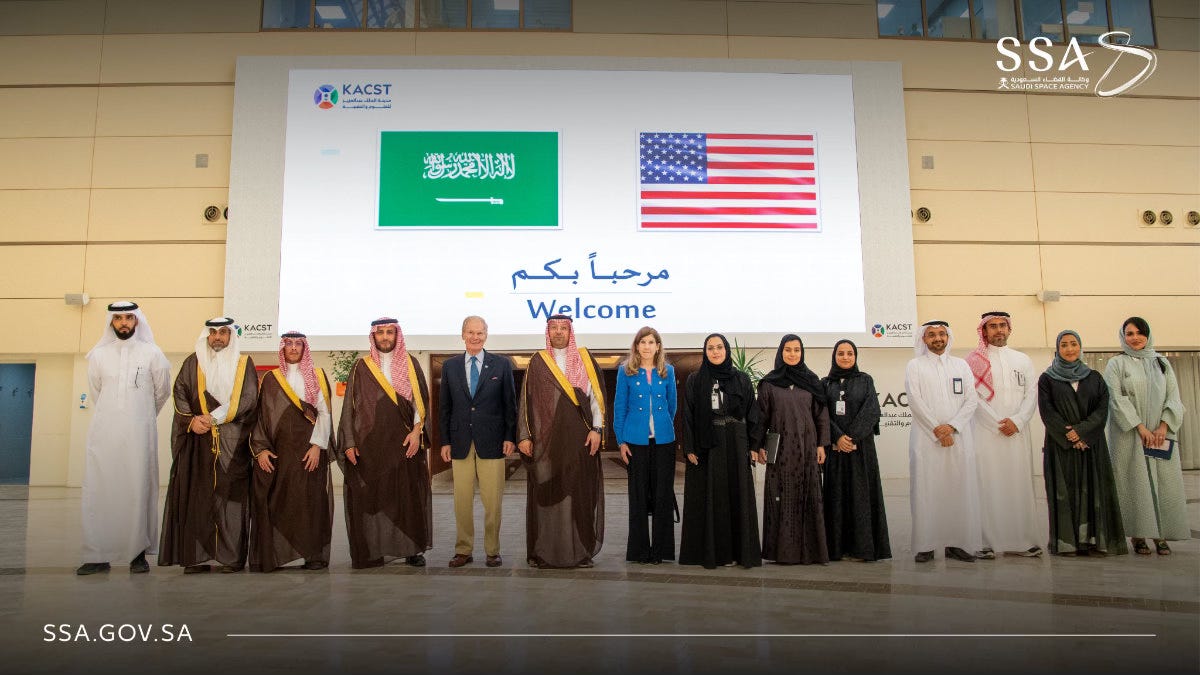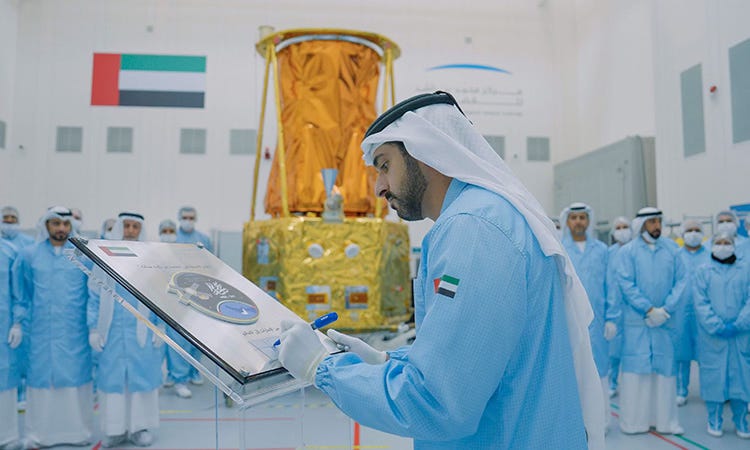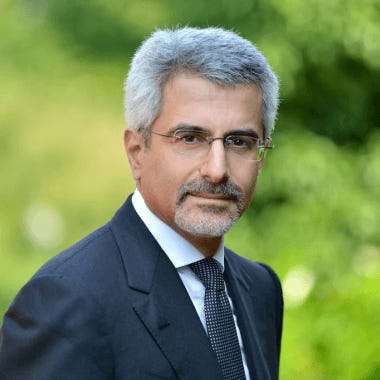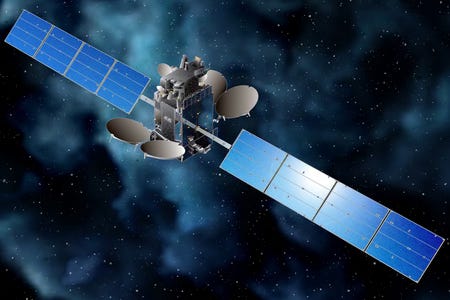Middle East Space Roundup: 13 to 19 May 2024
A summary of all the space news in the Greater Middle East over the past week, brought to you by AzurX

The following are the major space developments in the Greater Middle East region tracked by Middle East Space Monitor over the past week:
Saudi Arabia Space News
Boston Consulting Group and Saudi Arabia Struggle With Space Strategy
The U.S. consulting firm Boston Consulting Group (BCG) is nearing completion of a multi-year project aimed at defining Saudi Arabia's comprehensive space strategy. However, the firm faces challenges in reconciling the demands of various Saudi space and technology organisations whose future roles and responsibilities hinge on BCG's recommendations. At the crux of the matter are disagreements over the delineation of duties between the Saudi Space Agency (SSA) and the Communications, Space & Technology Commission (CSTC), both chaired by the Minister of Communications and Information Technologies, Abdallah bin Amer Al Swaha, who sponsored the project. BCG's space sector specialists, led by Troy Thomas and formerly Sita Sonty, have undertaken extensive feasibility studies, governance modeling, regulatory frameworks, and analytical assessments to develop a multi-year implementation programme spanning hundreds of pages. While discretion surrounds the project's details, the overarching strategy aims to establish Saudi capabilities in upstream space exploration and downstream space technology development, including telecoms, satellite navigation, and Earth observation for environmental monitoring. As the project nears finalisation, its recommendations will shape the future landscape of Saudi Arabia's burgeoning space industry.
Saudi Arabia’s SARsatX Receives Investment from Flat6Labs
Flat6Labs, a prominent seed and early-stage venture capital firm in the Middle East region, has disclosed its investment in SARsatX, a satellite startup operating in Saudi Arabia and the UAE. SARsatX, part of Cycle 3 of the Riyadh Seed Program, specializes in synthetic aperture radar (SAR) payloads, offering precise Earth observation (EO) data and analytics across sectors like agriculture, finance, and energy. Leveraging SAR technology and advanced machine learning, SARsatX equips stakeholders with critical insights for informed decision-making. Flat6Labs’ investment underscores SARsatX’s potential and highlights the rising significance of space tech in diverse industries. As a key player in seed investment, Flat6Labs’ backing reaffirms SARsatX’s trajectory and the broader appeal of space-based solutions. This investment builds upon previous funding rounds, including support from the KAUST Innovation Fund, solidifying SARsatX’s position in the burgeoning regional space technology landscape.
Space Debris Seen Falling Over Saudi Arabia
In an unusual event, debris from a spacecraft was observed falling in Saudi Arabia's Empty Quarter desert at 3:30 am on 13 May 2024, with some individuals capturing images and videos of the incident. According to Muhammad Hindi, a Saudi telescope expert and astronomer, there is a possibility that the debris belonged to the SpaceX Dragon capsule, which supplies the International Space Station (ISS) with equipment and tools. Hindi's analysis of a video made by a Riyadh resident suggests that the debris fell south of Al-Kharj in the Empty Quarter desert, with the fast-moving light emitted from the debris indicating that parts of the spacecraft may have fallen in various regions of Saudi Arabia. This incident highlights the growing concerns surrounding space debris management and the potential risks associated with the increasing number of satellites and spacecraft in orbit. It also emphasises the need for international cooperation in addressing space debris to ensure the safety of space activities and terrestrial populations, as the consequences of such events can have far-reaching implications for both the space industry and the general public.
NASA Administrator Bill Nelson Visits Saudi Arabia, Strengthens Ties
In a significant development for Saudi Arabia’s space sector, Prince Sultan University in Riyadh hosted a joint delegation from the Saudi Space Agency (SSA) and NASA, including high-level officials and Saudi astronauts. The event aimed to discuss ways to enhance cooperation in science, research, development, and innovation, as part of the SSA's ongoing efforts to develop national capabilities and competencies in the space sector. During the visit, NASA Administrator Bill Nelson highlighted the potential of the Center for Space Futures, a collaboration between the SSA and the World Economic Forum, to bring together commercial and government programmes to build a significant space economy, projected to reach nearly $2 trillion by 2035. Nelson also emphasised the importance of the partnership between NASA and Saudi Arabia, which includes collaborations on scientific instruments for the Artemis II lunar mission and efforts to address space debris, a major threat to satellites and spacecraft. The Artemis Accords, signed by Saudi Arabia in 2022, were also discussed as a set of principles for the peaceful use of space and international cooperation. The Saudi space industry holds great potential for growth, with revenue of $400 million in 2022 and the global space economy projected to expand to $1.8 trillion by 2035. This rapid surge is driven by reduced costs and broader accessibility to space-enabled technologies across various commercial sectors, and enhanced collaboration between public and private stakeholders will be crucial to fully realise the sector's potential in the future.
Iran Space Developments

Detailed OSINT Analysis of Iran’s Chabahar Space Launch Site Released
In recent years, Iran has made significant progress in constructing its new national space launch base near Chabahar, which is poised to become the country's most important site for supporting its ambitious future space goals. The exact layout of the base remains unclear, but it is expected to include three launch pads for solid and liquid-propellant space launch vehicles (SLVs), as well as extensive support facilities. The construction and operation of the Chabahar base are being implemented in three main phases, with the first phase focusing on the infrastructure necessary for launching solid-propellant SLVs. Recent satellite imagery analysis has identified the probable assembly building and a possible launch pad under construction, which are noticeably different from the conceptual designs presented in 2020 and 2021. The initial phase of construction is located behind a large ridgeline, further away from the coastline than previously envisioned. As Iran progresses through the phases of construction, it aims to conduct launches to sun-synchronous orbit (SSO) using solid-propellant SLVs, such as the AIO's Zoljanah SLV and possibly the Islamic Revolutionary Guard Corps’ (IRGC) Ghaem family SLVs, as early as March 2024-March 2025. The base is also expected to support Iran's "humans-to-space" programme, including launches of sounding rockets and developmental space capsules. While Iran still has a long way to go to achieve its ambitious goals of launching satellites to geostationary orbit (GEO) and astronauts into space, the progress at the Chabahar base will be closely watched by the international community in the coming years.
Iran’s IRGC Aims to Test Launch Qaem-105 SLV by Spring 2025
Brigadier General Ali Jafarabadi, Commander of the Islamic Revolution Guards Corps (IRGC) Aerospace Force's Space Division, has provided insights into Iran's upcoming space endeavours. Notably, the IRGC Aerospace Force aims to conduct a test launch of the next-generation Qaem-105 satellite launch vehicle (SLV) by the end of this year or, if faced with delays, in the spring of 2025. A significant advancement, the Qaem-105 boasts nearly twice the payload capacity compared to its predecessor, the Qaem-100. This enhanced lifting capability underscores Iran's commitment to expanding its space programme's capabilities. Furthermore, General Jafarabadi revealed that within the next three years, Iran intends to initiate research into launching satellites using the even more powerful Qaem-120 SLV. These developments demonstrate Iran's technological progress in space exploration and its aspirations to establish a robust presence in the global space industry.
Iran’s IRGC Plans for Satellite Constellation, Geostationary Launch Vehicle
The Islamic Revolution Guards Corps (IRGC) has revealed plans to develop its own satellite constellation, according to Brigadier General Ali Jafarabadi, commander of the IRGC Aerospace Force’s Space Division. This constellation, which could consist of anywhere from five to 500 satellites, is a strategic agenda for the IRGC, necessitating the establishment of infrastructure for satellite manufacturing and the stabilisation of the satellite launch industry. Brigadier General Jafarabadi has also indicated plans for the Qaem-120 satellite launch vehicle, intended to launch satellites into a higher orbit of 36,000 kilometers above Earth, within the next three years.
Israel Space Developments
Israel to Develop Satellite in Honour of Fallen IDF Officer Killed in Gaza
The Technion – Israel Institute of Technology and Israel Aerospace Industries (IAI) have joined forces to develop a communications satellite named NOVA-SAT in honour of Captain (res.) Denis Krokhmalov Veksler, a fallen Israel Defense Forces (IDF) officer who was set to begin his studies at the Technion. Veksler, a respected athlete and an officer in the elite Yahalom engineering unit, had planned to study aerospace engineering at the Technion before his untimely death in Gaza in January 2024. The satellite project, led by Dr. Hillel Rubinstein from IAI and Dr. Oded Golan from the Technion's Faculty of Aerospace Engineering, serves as the final project for students at the faculty. NOVA-SAT will be equipped with the GALI (Gamma-ray Burst Localizing Instrument) detector, developed at the Technion's Faculty of Physics, to detect bursts of gamma radiation produced by various astronomical events such as supernovae, mergers of neutron star pairs, and the explosion of stars at the end of their lives.
Ilan Ramon Scholarship Project Sends Israeli Images to the Moon
The Ilan Ramon Scholarship Project has made history by sending Israeli space images and photos to the Moon, marking a significant milestone in space exploration. Amidst challenging times, characterised by Yom Hazikaron, Israel's national day of remembrance, the project aims to inspire hope and optimism for the future. Israeli President Isaac Herzog emphasised the importance of space exploration in advancing humanity's collective endeavours and addressing pressing global challenges. The Institute of Space Commerce facilitated the inclusion of an image of Ilan Ramon, an Israeli astronaut, in a 2024 lunar mission, highlighting the project's commitment to inspiring young minds in science and technology. As a non-profit organisation, the Institute of Space Commerce promotes research and engagement to foster a commercially viable and sustainable space economy. The Ilan Ramon Scholarship Project, affiliated with the International Space University, continues to support Israeli post-graduate students in pursuing space studies, contributing to the global space community and ecosystem.
Israel’s hiSky Positions to Compete with Starlink in Global SATCOM Market
hiSky Satellite, an Israeli company providing satellite communication services across industries like agriculture and shipping, is gaining global attention for its innovative approach compared to major players like Starlink. Unlike owning its own satellite network, hiSky develops terminals that can flexibly connect to various wireless satellite services, offering cost-effective connectivity solutions tailored to specific bandwidth needs. This versatile model has led to collaborations with industry giants like CNH and Intelsat, competing against Starlink for major agriculture contracts. As the commercial satellite IoT market is projected to grow to $2.9 billion by 2027, driven by low-Earth orbit satellite demand and industrial expansion, hiSky's $60 million-funded platform positions it strategically. With over 100,000 commercial satellites expected by 2030, major enterprises and governments are increasing investment, exemplified by massive deals like Amazon's 3,000-satellite launch and Europe's €6 billion IRIS² project, underscoring the burgeoning opportunities in this rapidly evolving sector.
UAE Space Developments
UAE’s Yahsat Announces Thuraya-3 Satellite No Longer Operational in Australia
Yahsat, the UAE-based satellite communications company, has announced that its Thuraya-3 mobile communications satellite has experienced a major outage due to a "sustained force majeure event," rendering the satellite unrecoverable and significantly diminishing related services. Launched in 2008, Thuraya-3 provided L-band satellite services via its dedicated satellite phone, primarily covering South and East Asia and the Pacific region. While the exact technical fault remains unclear, Yahsat has partially restored services to some parts of the Indo-China region by reconfiguring Thuraya-3's sister satellite, Thuraya-2. However, the reconfiguration cannot extend coverage to Australia, leaving Australian customers, including emergency services, without access to satellite connectivity. As a result, Australian satellite service provider Pivotel has been forced to offer alternative services from companies like Inmarsat and Iridium at reduced prices. The failure of Thuraya-3 has been particularly disappointing, as a 2020 audit conducted by its manufacturer, Boeing, on behalf of Thuraya, had suggested that the satellite would remain serviceable until 2031. This incident highlights the importance of robust contingency plans and the need for satellite operators to have backup systems in place to ensure uninterrupted service for their customers.

Dubai’s Crown Prince Approves MBRSC’s MBZ-SAT Earth Observation Satellite
Sheikh Hamdan Bin Mohammed Bin Rashid Al Maktoum, Crown Prince of Dubai and President of the Mohammed Bin Rashid Space Centre (MBRSC), has officially approved the launch of MBZ-SAT, the most advanced Earth observation satellite in the region, marking a significant milestone in the UAE's space endeavours. During his visit to MBRSC, Sheikh Hamdan was briefed on the satellite's development, capabilities, and strategic deployment plan, expressing confidence in the centre's ability to enhance the Arab region's stature in the global space industry. The MBZ-SAT, fully developed and built by a team of Emirati engineers, represents a leap forward in technological prowess and has played a key role in enhancing the sustainable space economy in the UAE by involving local companies in the manufacturing process. Equipped with one of the most powerful cameras ever developed in the region, the satellite can capture high-resolution images with unprecedented clarity, meeting growing commercial demand and positioning the UAE as a hub for high-tech space technology development and innovation. Following its launch, scheduled for no earlier than October 2024 on a SpaceX rocket, MBZ-SAT will be operated and monitored from the Mission Control Centre at MBRSC, joining the ranks of the UAE's currently active satellites and significantly enhancing the country's space capabilities.
UAE’s Thuraya Partners With Cobham SATCOM for IP NEO
The UAE’s Thuraya Telecommunications Company has unveiled IP NEO, marking the debut of a new series of cutting-edge satellite communication products tailored for various sectors including government, NGOs, energy, and enterprises. Developed in collaboration with Cobham SATCOM, renowned for robust satcom solutions, IP NEO showcases Thuraya's dedication to meeting the evolving needs of its clientele. As a lightweight portable L-band broadband data terminal, IP NEO capitalises on the advanced features of the Thuraya-4 Next Generation System (T4-NGS) to offer enhanced connectivity and extended coverage. This launch precedes a broader rollout of next-generation broadband products, encompassing vehicular and maritime terminals, along with mobile gateways. Ali Al Hashemi, Yahsat's Group CEO, expressed excitement over the collaboration's potential for innovation, while Cobham SATCOM's CEO, Christophe Duret, highlighted IP NEO's adaptability to diverse industry requirements, emphasising its efficiency for infield operations in crisis scenarios.
UAE and France Expand Space Cooperation, Focus on Lunar Exploration and Satellite Data to Combat Climate Change
The UAE and France have reaffirmed their dedication to bolstering bilateral space cooperation, with a distinct emphasis on lunar exploration missions and leveraging space data to combat climate change challenges. This strategic alignment underscores the two countries’ shared vision of advancing space exploration while simultaneously harnessing its applications to address pressing environmental concerns. Moreover, the decision to broaden the Space Sub-Committee of the UAE-France Strategic Dialogue to encompass major stakeholders from both countries' space ecosystems, encompassing space centres, industrial entities, SMEs, startups, universities, and operators, signifies a comprehensive approach to fostering synergies and cross-pollination of expertise. This inclusive framework not only fortifies the growing ties between the UAE and French space sectors but also positions them as collaborative leaders in driving innovation, sustainable practices, and knowledge-sharing within the global space community.
Türkiye’s Space Developments
Türkiye’s Türksat-6A to be Sent to U.S. in June for July 2024 Launch
Abdulkadir Uraloglu, Türkiye’s Minister of Transportation and Infrastructure, announced that Türkiye is preparing to send its first domestic and national communication satellite, Turksat-6A, to the United States in early June, with the launch scheduled for July 2024. The satellite, nearly 90% locally produced, is a significant milestone in Türkiye's efforts to enhance its national space capabilities and ensure secure military communication. Turksat-6A was developed by training Turkish engineers using experience gained from previous satellites, with the involvement of thousands of engineers and technicians from various organisations, including Turksat, TUBITAK UZAY, Aselsan, and CTECH. The new satellite will expand Türkiye's coverage to four new countries – India, Thailand, Malaysia, and Indonesia – increasing the total coverage to over 5 billion people from the existing 3.5 billion. This expansion not only strengthens the country's ability to provide secure communication within its existing footprint but also creates the potential for significant revenue growth by selling communication services to these countries. With Türkiye now among the 10 countries capable of producing such satellites, the country is well-positioned to meet the needs of potential customers worldwide.
Türkiye’s Satellite Manufacturing Capabilities Provide Geopolitical Influence
Türkiye's advancements in satellite manufacturing and its imminent launch of Türksat-6A positions the country as a significant player in the space sector. Türkiye's achievements emphasise the strategic importance of satellite networks for communication and reconnaissance in shaping geopolitical influence. Satellite technology has a critical role in national security, economic growth, and geopolitical influence, positioning Türkiye and other spacefaring countries at the forefront of this evolving landscape.
Other News
Azerbaijan’s Azercosmos Poised to Benefit from Boom in Global SATCOM Demand
At the GSMA M360 Eurasia 2024 conference in Baku, Azerbaijan, Fuad Aslanov, vice-chairman of Azercosmos, highlighted the agency's current operations and the immense growth potential in the satellite communications market. Azercosmos presently operates two telecommunication satellites, providing services across 50 countries. Aslanov noted the satellite communications market, valued at $20 billion currently, is projected to surge to $123 billion by 2032, underscoring the industry's burgeoning prospects. Moreover, he emphasised the pressing need for effective emergency alert communication systems where meaningful progress has been made over the past two years through successful testing. The GSMA M360 Eurasia event, sponsored by Azercell and backed by Azerbaijan's Ministry of Digital Development and Transportation, serves as a platform for industry leaders, regulators, and policymakers to convene and shape the future of mobile connectivity and telecommunications in the region.
Humanitarian NGO’s Appeal to Starlink to Maintain Operations in Sudan
Nearly 100 humanitarian organisations and members of the #KeepItOn coalition have urgently appealed to Elon Musk's Starlink not to terminate its satellite internet service in Sudan. They argue that any shutdown would violate human rights, amount to collective punishment of millions of Sudanese civilians, and critically disrupt aid operations relying on Starlink as a lifeline amid the country's prolonged telecommunications blackouts and infrastructure damage from ongoing conflict. The coalition, including groups like Save the Children and Islamic Relief Worldwide, warns that disrupting this connectivity could have fatal consequences for vulnerable populations and the NGOs trying to reach them. While Starlink recently announced plans to restrict roaming in unlicensed jurisdictions like Sudan, the appeals highlight the essential role of satellite internet in enabling emergency services, financial transactions, and humanitarian access when formal networks are crippled during crises. As Starlink navigates mounting pressures over its operations in conflict zones globally, this case underscores the complex balance between regulatory compliance and ensuring civilian protection.
Azerbaijan’s Azercosmos to Provide Earth Observation Data to Agricultural Sector
Recognising the vital role of satellite technology in sustainable agriculture and climate change mitigation, Azerbaijan's Ministry of Agriculture and Azercosmos have signed a transformative Memorandum of Understanding. Under this accord, satellite imagery will be leveraged to create comprehensive crop mapping across the country's agricultural regions and develop a geographic database for pivot irrigation systems. This initiative holds profound significance as it aims to assess climate change's impacts on the agricultural sector through space-based monitoring solutions. With 30-40% of global farming operations already utilising satellite data for precision agriculture practices like crop health monitoring and yield forecasting, this collaboration positions Azerbaijan at the forefront of harnessing space technology for environmental stewardship. The insights derived will be valuable as the country prepares to host the pivotal COP29 climate summit. Complementing this endeavour, Azercosmos recently launched a digital climate platform, climatereport.az, showcasing Azerbaijan's commitment to addressing global climate challenges through innovative sustainability initiatives underpinned by cutting-edge space applications.
Other News in Brief
Among the other regional space and satellite developments over the past week are:
Yahsat, the UAE satellite services firm and one-half of the upcoming Space42 entity, reported record financial results for Q1-2024, with net income reaching Dh194 million ($53 million) and revenues soaring to Dh371 million ($101 million);
UAE’s Bayanat, the AI-driven geospatial solutions provider listed on the Abu Dhabi Securities Exchange (ADX), has reported its first-quarter financial results for 2024, demonstrating substantial growth and strategic advancements;
The Crown Prince of Dubai chairs a Board of Directors meeting of the Mohammed Bin Rashid Space Centre (MBRSC).
Recommended Reading
Saïd Business School Faculty Provide Comprehensive Guide to UAE Space Sector
Writing for Oxford Answers, Michele Scataglini, Marc Ventresca, and Fatema Al Hajri provide the most comprehensive guide to, and overview of, the UAE’s evolving space programme and sector. The UAE has been making significant strides in developing its space sector, with a clear regulatory framework, a growing ecosystem of actors, and substantial public and private funding. The UAE Space Agency, established in 2014, serves as the national coordinating body, overseeing the implementation of the National Space Strategy 2030, which encompasses six main goals, 20 programmes, and 80 initiatives. Notable achievements include scientific missions to the Asteroid Belt, Moon, and Mars, agreements with leading international space organisations, and the UAE's leadership in regional space cooperation through the Arab Space Cooperation Group.
The UAE space ecosystem is growing in scale and scope, with government agencies and state companies leading the way. The Mohammed bin Rashid Space Centre (MBRSC) focuses on Earth observation satellites, the UAE Astronaut Programme, and the Mars 2117 Programme, while Space42, a proposed merger of Yahsat and Bayanat, offers multi-mission satellite services and AI-powered geospatial solutions. Industry incumbents and national champions, such as EDGE Group, also play a significant role in the ecosystem, with EDGE serving as the prime contractor for the Sirb synthetic aperture radar (SAR) satellite programme, which aims to enhance the country's capabilities in developing and manufacturing satellite components.
Research and technology activity fields are burgeoning, with institutions such as the Propulsion and Space Research Centre (PSRC) and Directed Energy Research Center (DERC) at the Technology Innovation Institute (TII), Khalifa University Space Technology and Innovation Lab (KUSTIL), National Space Science and Technology Centre (NSSTC), and Sharjah Academy For Astronomy, Space Sciences and Technology contributing to the development of innovative space activities and research programmes. The UAE is also investing in education and talent, with the launch of the National Space Academy and educational sessions focusing on space and remote sensing during COP28.
The UAE's commitment to developing its space sector is evident in the venture support for innovation and entrepreneurship, with programs dedicated to supporting space startups and the establishment of the Masdar Space Economic Zone. The country's long-term vision and financial resources, including the $820 million National Space Fund, position it well to continue growing its space economy and playing a leading role in the global space industry.

Designated Managing Director of UAE’s Space42 Shares Views on UAE Space Sector
In Arabian Business, the designated Managing Director of Space42, Karim Michel Sabbagh, writes that the UAE has emerged as a global front-runner in the modern space race, thanks to its progressive and integrated approach that aligns and implements a strategic and multifaceted vision supported by both private and public sectors. The UAE's commitment to the space sector, driven by a clear understanding of its significant economic and geopolitical potential, has been instrumental in regional space development. The establishment of centres of excellence, such as the UAE Space Agency and the Mohammed bin Rashid Space Centre, along with the development of the National Space Strategy 2030 and the AED3 billion (US$816.84 million) National Space Fund, have laid solid foundations for the realisation of a bold space technology, science, and research agenda. The UAE's investment of AED25 billion ($6 billion) in advanced infrastructure, coupled with its pledge to support and expedite the country's space capabilities over the next decade, demonstrates the government's commitment to fostering a dynamic private space sector. The UAE believes in creating an integrated ecosystem that encourages collaboration across public and privately led projects, as exemplified by the merger between Bayanat and Yahsat to create Space42, an AI-powered space technology champion. By blending key elements such as cutting-edge technologies, strategic partnerships, and investments, the UAE is not only redefining the opportunities that the space sector offers but also determining how it can directly enhance the development of human knowledge and create a stronger, more sustainable, and brighter future for everyone.
Also Read…
The Role of Earth Observation in the Dubai Mangroves Project
In BroadcastProME, Serco’s Amar Vora writes that the Dubai Mangroves project represents a significant step forward in the fight against climate change, aiming to transform the urban environment through ecological preservation and sustainable urban development. Urban Twin solutions, underpinned by state-of-the-art Earth observation data, can provide a complete 360-degree environmental overview and enable evidence-based decision-making throughout the planning, planting, and monitoring phases of the project.
PLANETech Puts Israel in Pole Position for Space-Based Climate Tech
In CTECH by Calcalist, Noam Sonennberg and Yaroslav Efimov write that amid escalating climate change threats, Israel’s PLANETech underscores the pivotal role that Earth observation and satellite technologies can play in combating global warming. Key applications include greenhouse gas emissions tracking, precision agriculture, biodiversity monitoring, and enhanced climate modeling. Israel, with its aerospace expertise and thriving high-tech ecosystem adept in AI, data analytics, and collaborative R&D, is uniquely positioned to spearhead advancements in dual-use space technologies serving both defence and climate tech sectors.
Be sure to catch up with space activities in the region in the next edition of Middle East Space Monitor’s space roundup!





